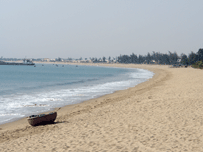
|
|
| Ninh
Chu Beach |
|
With
most tours only stopping over in Ninh Thuan to visit the Po
Klong Garai Towers or spend a night at the Ninh Chu Beach
outside of Phan Rang, visitors end up missing much of the
diversity the area has to offer.
As
the driest province in the country, with annual rainfall totals
between 700 mm and 1100 mm, Ninh Thuan is endowed with a diverse
topography of coastline, deltas, mountains, rivers, and sand
dunes.
Located
344 km northeast of HCMC and 147 km south of Nha Trang, Ninh
Thuan boasts some of the most beautiful beaches in Vietnam.
The 10-km long Ninh Chu Beach is prime for development because
of its proximity to Phan Rang. For more seclusion try the
remote Ca Na and Binh Tien beaches.
Forty-two
km northeast of Phan Rang is Vinh Hy Bay. From the main-land
in Vinh Hy visitors can take a boat trip to the Hon Do coral
beach. Hon Do is a gorgeous beach that contains 307 varieties
of coral.
|
TIPS
■
Avoid touring in the harsh afternoon sun
■
Round-trip bus between Mien Dong Bus Station (HCMC)
and Phan Rang:
Minh Dung Bus: Tel (08) 511 5234
Quoc Trung Bus: Tel (068) 830 200
■
Phan Rang local bus station: 23 Thong Nhat St., Phan
Rang - Thap Cham, Tel: (068) 822 926
■
Train Agent: 351 Thong Nhat St., Phan Rang - Thap Cham,
Tel (068) 834 008
■
Taxi Agents:
Ngoc Hoa Taxi: (068) 838 383
Ninh Thuan Taxi: (068) 888 111
Mai Linh Taxi: (068) 898 989 |
Ninh
Thuan boasts a number of interesting sand dunes along the
shoreline. The most well-known is the Nam Cuong sand dunes
a few kilometers south of Phan Rang near the Lu River. At
Nam Cuong visitors can watch the colors of the sand changing
as the sun sets in the evening. The local children will goad
tourists into playing games with them.
Other
provincial attractions include the salt fields in Phuong Cuu
and Tri Hai, and the vegetable gardens in the villages of
Van Hai and Van Son.
Ninh
Thuanís Cham culture
The
culture of Ninh Thuan is deeply influenced by the 50,000 or
so ethnic Cham living in the province. Cham festivals are
considered provincial public holidays.
The
Cham are well-known for their traditional handicrafts. In
the village of My Nghiep, 12 km south-east of Phan Rang, visitors
can see firsthand the weaving techniques of the Cham as they
make decorative cloth. For a display of ceramic production,
head to the village of Bau Truc about 10 km south from Phan
Rang. It is believed that the composition of the clay from
the Quao River is one of the secrets behind the beautiful
Bau Truc ceramics.
The
history of the Champa Dynasty shines through with a visit
to any of the three-tower sites of Hoa Lai, Po Klong Garai
or Porome.
The
Hoa Lai Towers, dating back to the ninth century, can be found
15 km north of Phan Rang on Highway 1A. This three-tower site
is considered the oldest relic of Cham architecture.
Po
Klong Garai Tower, located 6 km west of Phan Rang, sits atop
Trau Hill. Po Klong Garai was built by King Simhavarman III
at the end of 13th century. The towers were dedicated to King
Po Klong Garai, a king legendary for his protection of the
Champa Kingdom. The main tower faces the east and is a good
representation of Cham architectural and decorative style.
Porome
Tower is located about 17 km south of Phan Rang. Construction
on these towers began at the end of fifteenth century. The
site includes an 8-meter high main tower dedicated to King
Porome, the last king of the Champa Kingdom.
Reported
by Thu Giang
- ThanhNienNews 28 Oct 2007

